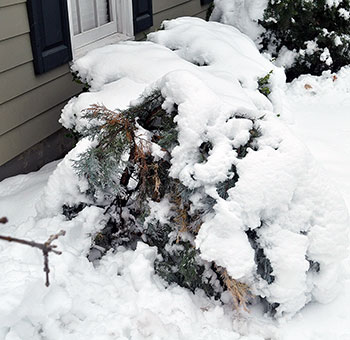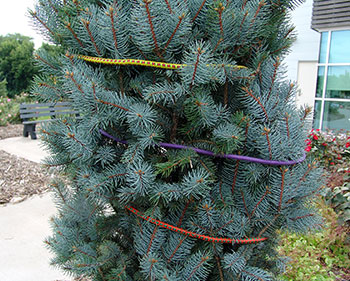Helping Evergreens Recover From Heavy Snow
Return to Trees and Shrubs Agent Articles
 Evergreens are an important part of any landscape, whether they're used in the front yard or spotted in a garden setting.
Evergreens are an important part of any landscape, whether they're used in the front yard or spotted in a garden setting.
The standard recommendation is to have at least one-third of the plant material in the front landscape be evergreen. This helps provide for year-round interest and color. Using evergreens in the perennial garden also provides year-round interest and creates what many call the “bones” of the garden — the constant structure needed to provide a garden’s character.
Many evergreens look sad after a heavy snow. They bend, droop and weep out of their natural shape. The question everyone asks is will they recover? I am glad to report good news. In most cases, yes. That is because many of our evergreens are resilient.
Be patient; Give them time
Evergreens, such as boxwood, arborvitae, false cypress, yews and junipers took a beating from the heavy snow and ice. The good news is these plants have very flexible branches. Because of these limber branches, most of the evergreens did not experience limb breakage. Instead, there are limbs that are all bent out of shape.
Given time the plant will naturally right or correct itself. Plants are made to take this type of damage from snow and ice. Don’t rush the natural process. Slowly the limbs will start to right themselves. This does not mean they will be as perfectly in shape as before. They may still be somewhat misshapen, but down the road, it will not be as noticeable. It may take six months to a year for this to occur.
My recommendation is to resist the temptation to help nature out. In other words don’t go out and pull, tie or stake the branches back into place. Doing this can weaken the limbs as they become dependent on the support rather than its natural wood. I know it is hard to resist the helping hand, but in this case, nature knows better.
Remove limbs that are broken, split or damaged from the storm. The plant cannot repair this type of damage. Leaving it in place or attempting to tie it back together can potentially lead to more damage. Often when a branch is removed, the opening allows sunlight penetration and new growth will slowly fill in, camouflaging the area.
An ounce of prevention is worth a pound of cure
 It’s hard to predict when the next snow storm will cause such damage. But there are a few simple practices that can be done to reduce the effects of the weight on the limbs. In the fall, before the first snow, wrap or tie together smaller, upright trees and shrubs. This involves circling the plant with a soft cord, old nylon hose or a bungee cord. Pulling the branches together and holding them upright can reduce the weight of the snow or ice.
It’s hard to predict when the next snow storm will cause such damage. But there are a few simple practices that can be done to reduce the effects of the weight on the limbs. In the fall, before the first snow, wrap or tie together smaller, upright trees and shrubs. This involves circling the plant with a soft cord, old nylon hose or a bungee cord. Pulling the branches together and holding them upright can reduce the weight of the snow or ice.
Be careful not to use a material that will cut into the bark and cause additional damage. The supports should be removed in the spring after winter danger has passed. Leaving the supports in place will weaken the strength of the limbs leading to more damage.
Another trick is to knock the snow off as it falls. This involves gently brushing off the limbs with a broom. Avoid vigorous motions that causes the limbs to shake or bounce as the weight of the movement can cause the limbs to break.
Brushing only works with powdery snow. It is best to wait for ice or frozen snow that has adhered to the limbs to melt. Brushing or knocking off the ice will break the branches and pulls off the needles causing more damage. The good news is that most evergreens are resilient and bend but do not break.
Have questions? The Garden Hotline is staffed by trained EMG volunteers and Extension staff who will assist you with questions.
Phone: (913) 715-7050
Email: garden.help@jocogov.org